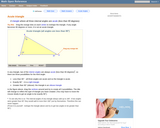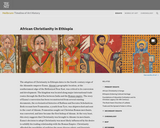
This online tutorial covers primary and secondary active transport.
- Subject:
- Science
- Material Type:
- Reading
- Provider:
- Khan Academy
- Date Added:
- 03/20/2017

This online tutorial covers primary and secondary active transport.

An interactive applet and associated web page that demonstrate acute angles (those less than 90 deg). The applet presents an angle (initially acute) that the user can adjust by dragging the end points of the line segments forming the angle. As it changes it shows the angle measure and a message that indicate which type of angle it is. There a software 'detents' that make it easy capture exact angles such as 90 degrees and 180 degrees The message and angle measures can be turned off to facilitate classroom discussion. The text on the page has links to other pages defining each angle type in depth. Applet can be enlarged to full screen size for use with a classroom projector. This resource is a component of the Math Open Reference Interactive Geometry textbook project at http://www.mathopenref.com.

An interactive applet and associated web page that demonstrate the three types of triangle: acute, obtuse and right. The applet shows a triangle that is initially acute (all angles less then 90 degrees) which the user can reshape by dragging any vertex. There is a message changes in real time while the triangle is being dragged that tells if the triangle is an acute, right or obtuse triangle and gives the reason why. By experimenting with the triangle student can develop an intuitive sense of the difference between these three classes of triangle. Applet can be enlarged to full screen size for use with a classroom projector. This resource is a component of the Math Open Reference Interactive Geometry textbook project at http://www.mathopenref.com.

This resource provides information on Adam Smith's moral and political philosophy.

In this article, students learn how to add or subtract two functions to create a new function.

An interactive applet and associated web page that demonstrate the the concept of adjacent arcs. The user can 3 drag points around a circle that define the endpoints of two adjacent arcs. Web page has the properties of adjacent arcs. Applet can be enlarged to full screen size for use with a classroom projector. This resource is a component of the Math Open Reference Interactive Geometry textbook project at http://www.mathopenref.com.

In this special revised and updated feature for Black History Month, teachers, parents, and students will find a collection of NEH-supported websites and EDSITEment-developed lessons that tell the four-hundred-year old story of African Americans from slavery through freedom and citizenship to the presidency.

Containing more than 50 articles from the award-winning Tar Heel Junior Historian magazine and over 40 lesson plans, this multidisciplinary Educator Notebook will enrich your exploration of North Carolina and American history with diverse perspectives. This resource's link takes you to a very short form that gives you free downloadable access to the complete PDF book.

This article explains how Christianity was adopted in Ethiopia in the fourth century. It also explains how Askum's geographic location played an important role in the development and spread of Christianity in this region.

This article examines the spread of Christianity in Kongo. It explains why the Kongolese adopted the religion and its impact.

This article in the New York Times covers this year's DanceAfrica festival and it's "revered and beloved" founder and master of ceremonies, North Carolina's own, Chuck Davis.

After losing costumes and sets to Hurricane Sandy, the Martha Graham Dance Company rebuilds, recreates and reinvents itself. It is the companion article to the video, Martha Graham: Myth and Transformation.

This reading resource reviews the history of agriculture in the state of North Carolina.

This article assesses the impact of this agrarian revolution. From the 16th century onwards, an essentially organic agriculture was gradually replaced by a farming system that depended on energy-intensive inputs.

This 1982 srticle reports on a program in which the late choreographer, Alvin Ailey, taught movement to blind students.

Students will read about the creation of air conditioning and the impact it had on the way people lived in North Carolina.

Article with links about air pollutants and the effect on humans

There is no known safe amount of alcohol to drink while pregnant. There is also no safe time during pregnancy to drink and no safe kind of alcohol. CDC urges pregnant women not to drink alcohol any time during pregnancy. Women also should not drink alcohol if they are planning to become pregnant or are sexually active and do not use effective birth control. This is because a woman could become pregnant and not know for several weeks or more. In the United States half of all pregnancies are unplanned. FASDs are 100% preventable. If a woman doesn't drink alcohol while she is pregnant, her child cannot have an FASD.

Questions and answers about Alcohol and Pregnancy.

In this informational text, elementary school readers learn about the difference between weather and climate and about components of the climate system. The text can be used to practice visualizing and other comprehension strategies. Available in K-2 and 3-5 grade bands and as an illustrated book as well as a text document, the story appears in the online magazine Beyond Weather and the Water Cycle.